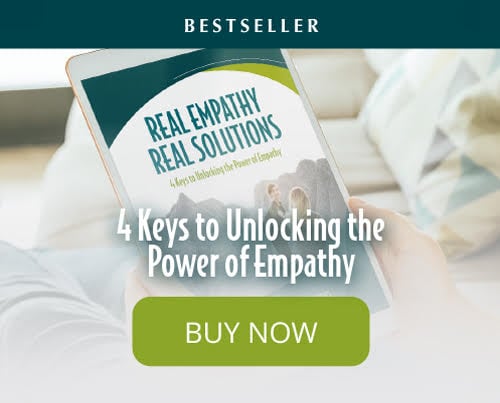The brain's first job is to keep us safe. That's important, right? Yes, of course. However, if we only spot what's wrong or focus on problems without solving them, we can get stuck in our relationships and lives.
In my first coaching with young adults, couples, or even company leaders, there is a common theme. They point out everything that's wrong. It's true, we have to know what we want to change and that's natural. However, many people get in a cycle of reacting to problems instead of solving them.
Estimated reading time: 4 minutes
It's easy to slip into negativity with so many demands on our time and resources. Problems in relationships or business are often dreaded and sometimes avoided altogether while we use complaining and blaming to relieve stress. Many people consider problems annoying at the very least and insurmountable at the worst.
Until we master ourselves, nothing changes.
We must commit to a growth mindset, or problems will remain. Shifting our perspective is the first step. And often, there are emotional intelligence skills missing.
What If Problems Were Only an Invitation for a New Perspective?
Problems are a natural part of life and growth, but they can destroy a marriage or the vitality of a business team when we ignore them or allow them to control our responses.
If we don't use problems to move us forward in creating more mature and healthy relationships, they very quickly take over, just like unattended dandelions in the yard.
The Growth Mindset—an Excellent Example of a Problem Turned to Opportunity
The good news is that if we reframe our challenges in a positive light, problems can be a powerful catapult for ingenuity and richness in our lives, business, and relationships. It isn't difficult, but it takes a brand-new perspective and focused attention. Here's a story to illustrate this mind shift:
In 1941, George de Mestral, a Swiss engineer, went on a hike with his dog in the Alps. When they returned home, they were both covered with burrs.
At first, de Mestral was greatly annoyed as he tediously plucked them off his clothes one by one. Then, pulling those burrs from his dog's fur was even more time-consuming.
Then his perspective shifted. He got curious.
What made these burrs stick so tight, anyway?
Examining the burrs under a microscope, he discovered small hooks that burrowed into the tiny loops of cloth—and the idea of Velcro was born!
De Mestral patented Velcro in 1955, and by 1959, he was selling more than 60 million yards every year. Forty years later, the annual sales of Velcro were over 250 million yards!
How many people had cursed the burrs that clung so stubbornly to their clothes before de Mestral came along?
How many people discarded them with disdain while their secret remained unseen?
When we curse, dread, or avoid problems in our personal and work relationships and treat them like foes, we are blinded, and we miss opportunities to grow and strengthen the love in our marriage or the innovation, creativity, and synergy in our organizational culture.
However, if we see problems as friends and seeds of greatness, our attitude shifts dramatically.
Problems Are the Voice of a Better Way!
When working with clients, they lay their issues out in great detail, almost like they're collecting reasons why they're just too hard to solve. Many times, I'll ask them, "What do you want instead?" It's remarkable how frequently they shrug their shoulders and say "I don't know."
We can choose to put our attention on the problems or on the opportunities hidden inside. By reframing problems, we open a window to brighter light. It doesn't matter if it's a grumpy spouse, a rebellious teen, a declining product line in business, or an upset customer; these "annoyances" are clues for exploring opportunities for growth.
Let's isolate and break down how de Mestral shifted his attention and converted his "problem" into a money-making opportunity. Let's learn from his ingenuity and look at a step-by-step process to transform everyday annoyances.
Steps to Convert Problems to Opportunities
STEP 1: Isolate the specific problem.
The burrs within a partnership could be subtle criticism or jabs cloaked in sarcasm or your partner spending too much money.
In business, the burrs could mean an employee costing the company money with avoidable mistakes. Or you have a manager stuck in micromanagement, crushing employees' enthusiasm for new ideas in the name of efficiency.
Identify exactly what is bothering you, no matter what area of your life.
Then, break the problem down into manageable pieces. When you dissect a problem, frequently there are multiple components that need to be addressed and assist in creating effective solutions .

STEP 2: Reframe the problem by getting curious.
The key to solving problems is creating a new perspective and approaching the problem from a place of curiosity, as de Mestral did with the burrs.
Step out of reacting to the problem and ask what the ideal outcome would be. We rarely make good decisions when we are reacting to a person, experience, or problem.
Step back.
Breathe.
Get in touch with your values and what is most important to you.
And then, open to possibilities.
Related reading: "Apply Cognitive Priming to Positively Shift Your Emotions and Life."
STEP 3: Choose to take full responsibility.
Unfortunately, we can expend a lot of time, energy, and emotion without ever taking action. I've heard stories and talked with people who revolved angst over a friend's or co-worker's remark for weeks (or longer)! The more they churn, the stronger the emotion becomes. If we want quality relationships, we need to lean into the discomfort of having the difficult conversations—sooner!
In our personal lives or in the business world, there is often a lot of talk about problems for months (and even years) without taking action. Somehow, talking gives us the illusion of taking action, but many people can get stuck here.
Take responsibility for creating what you want in your life, relationships and business.
No one can change anything without action.
STEP 4: Ask yourself, "If this problem is an opportunity for learning, what is it trying to teach me/us?"
For instance, as a couple, your complaint might be, "We frequently come up short to pay the monthly bills." Every time you try to create a plan or a budget, it turns to an argument.
Looking at this problem from a place of curiosity, you could explore possible reasons. Perhaps you haven't set aside an emergency fund, or you're eating out in restaurants too often. And maybe, there's tension around money, not because your income isn't adequate, but because one of you has a spending problem. Yet, that's NOT the conversation you're having, even though it needs to be.
Whatever the problem, it is there to invite you to a better life.
Each problem allows us to better define what we WANT in life and relationships. Perhaps, you're unhappy in your job and feel stuck. Your desire might be hidden in the problem. This unhappiness (or problem) is asking you to grow, to advocate for yourself, to find your passion.
It's time to look squarely at problems.
Greet them with the eagerness you would a good friend you haven't seen for a while! With this mindset, life becomes a series of discoveries paving clear steps to success.
STEP 5: Decide what you want to replace the problem with.
The more specific you are, the more successful you will be.
For example, you want to save money and invest in your own home. In response to this goal, you choose to put $100 in savings every month by eating in restaurants only once a month. One small action that adds up.
If you decide to change careers, you would research possibilities and perhaps look at your interests, skillsets, and strengths.
With clarity comes power.
Each time you take action, you are moving closer to creating a life you love and the fulfillment of your goals and dreams. Problems invite us to act!
STEP 6: Take targeted action based on your conclusions.
The best way to capitalize on the opportunity that each problem presents is to take targeted action. Create a way to measure progress and reassess in a certain amount of time.
You will find that it's much easier to convert problems into opportunities than it is to go on living with the problems. It's just a matter of perspective.
Final Thoughts
Practice the steps above to create more mindfulness while continually moving forward productively. You may be pleasantly surprised by the results when a problem is just viewed as the voice of a better way.
Related reading: "What Is Emotional Intelligence?"
For more tips and support, please visit our Heartmanity resources or contact support@Heartmanity.com for our coaching programs.








